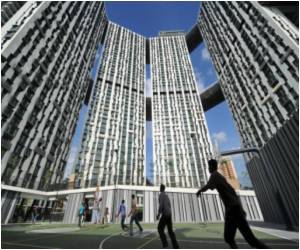
It is planning for a maximum population of 6.5 million in 20 years, which is 1,000th of the current world total of 6.5 billion.
Yet 1,000 times the land area of Singapore would occupy only 0.5 percent of the total world land mass, equivalent to about twice the size of Italy, Khoo said.
Maps at the exhibit shrink China and the United States to the tiny spaces they would occupy if they had the same density as Singapore, which has a land area of just 710 square kilometres (275 square miles).
The exhibition titled "1,000 Singapores: A Model of a Compact City" stresses the advantages of compactness such as minimising energy consumption, streamlining transportation and reducing the carbon footprint.
"Architecture, social systems, transport systems, waste management and so on are working hand in hand in a meta-project," Khoo told AFP, describing Singapore's evolution as a "very slow process of self-invention, as an island, a country, a city."
Advertisement
Increasing numbers of immigrants and guest workers jostle for space with the locals, and tourism is surging thanks to two new massive casino resorts that opened a few months ago.
Advertisement
And flash floods that wreaked havoc in June and July raised questions over whether the nation was equipped to handle the side effects of rapid urbanisation.
Back in Venice, Khoo said: "There is a heroic quality in thinking about the environment in that architecture can save the world, save the people, save the country."
He said Singaore wanted to "invite people to reflect on how human settlement can be," adding: "We do not have to continue to occupy a lot of land."
Fifty-three countries have pavilions at this year's Biennale, which opens Sunday and runs until November 21.
Source-AFP








